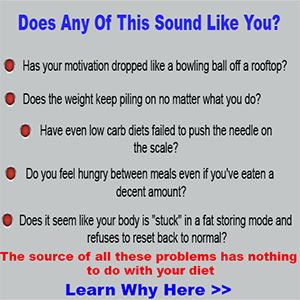Melt More Fat Sitting At Your Desk
We are all looking for ways to add more muscle. Muscle is a very metabolically active tissue, and just like a big V-8 engine, it burns lots of fuel. More muscle creates a bigger metabolic demand even at rest! Sweet! Burn more calories while just hanging out? Sign me up!
The main method your body uses to take amino acids from the protein you eat to create bigger muscles is called muscle protein synthesis (MPS if you are a geek like me). The more we can ramp up muscle protein synthesis in your body, the more muscle you can build.
Sounds pretty easy so far, right? Unfortunately there is a catch....(and a solution).
The 2 Main Ways
The two big triggers for increased protein synthesis (and more metabolically hungry muscle) for people of all ages are 1) weight training and 2) eating protein (2, 4, 6).
Many articles have been written about all the various ways to pick stuff up and put it down (which is very important), so we will focus on the second method of eating dietary protein.
Protein, when ingested, serves 2 main purposes: 1) raw building blocks for muscle and 2) turning on muscle protein synthesis (7, 9, 11). We need to optimize both processes for the maximal amount of muscle.
As long as you are eating some complete proteins like meats, dairy, eggs and even protein supplements with whey, you have all the raw materials covered.
Maximal Muscle Ahead
To stimulate more muscle, we need to flip the switch to kick start the whole building process of assembling amino acids into muscle protein. Did you watch much TV as a kid? I know I did (ok, probably a bit too much). One show that sticks in my head was the Laverne and Shirley show. Yeah, I know, I know, I am dating myself now, but in the beginning of each episode, Laverne and Shirley are working at an assembly line.
Imagine that each item coming down the line is an amino acid on its way to becoming muscle tissue. If the assembly line grinds to a halt, no more muscle is going to be made.
Ideally, we want the assembly line running as often as possible creating more muscle. Remember that your body is constantly building up and tearing down muscle tissue. This turnover of proteins can be up to 25% of resting energy expenditure (12). Just like a big car burns lots of fuel, it takes lots of energy to keep this repair process going.
Eat Multiple Times Per Day?
I am sure you have heard the advice that you need to eat protein multiple times during the day to keep protein synthesis (the building up process) chugging along.
While this is true......there is a catch.
In an experiment conducted by Bohe et al. (3) they used an IV infusion of protein to keep levels very high for many hours. The common assumption is that protein synthesis would also stay elevated too.
But physiology is not always that logical. After about 3-4 hours, DESPITE elevated blood levels of amino acids, muscle protein synthesis DROPPED.
Uh oh.
The protein building process has been halted! Someone pulled the plug on the assembly line, even though we had plenty of raw material present! In humans it has been shown that after eating a protein meal, protein synthesis will stay elevated for about 2 hours and then drops off (1, 10).
Prolonged Protein Synthesis
We now know that elevating amino acids in the blood all the time is not enough to keep adding more muscle. Perhaps there is a way to keep the assembly line marching along longer?
BCAAs to the rescue!
In a new study conducted by Wilson, GJ et al. (13) in our fury tailed friends, they tested an intervention of leucine (an amino acid), carbohydrates, and a combination of leucine and carbohydrates after a standard protein meal in regards to protein synthesis.
In the study (13), the rats were trained to eat 3 times per day. Then on test day did not consume any food for 12 hours (fasted) while blood was checked at 0, 90, or 180 minutes after a standard meal.
At 135 minutes after the meal, the rats got one of 4 items 1) carbohydrates only, 2) the amino acid leucine only or 3) combination of leucine and carbohydrates or or 4) water (served as a control group).
The goal was to extend the time protein synthesis stayed active beyond the standard 2 hour period.
Did It Work?
The researchers found that the critters given leucine, carbohydrates, or the combination of both did see an extension of muscle protein synthesis.
Awesome!
The assembly line process on the way to more muscle did not come to halt at the usual two-hour mark, but continued on!
All three interventions (leucine, carbs, or leucine + carbs) did the trick, which begs the follow-up question; which one is the best?
In the same study (13), they also measured insulin. Remember that insulin can be thought of as a "fuel selector switch" where high levels of insulin shift the body away from burning fat and towards using carbohydrates. While this is great before an intense weight training session, it is not a good thing to keep insulin levels jacked sky high all day as it impedes burning fat (5)!
The intervention of the carbohydrate only or in combination with leucine showed elevated levels of insulin. However, this was not seen in the leucine only group as insulin was not elevated.
Therefore, taking leucine only (without carbs) about 2 hours after a meal keeps the muscle building assembly going, but allows insulin levels to go back down and not imped the fat burning process in the body!
A two for one!
Leucine Is The Winner, Right?
Good thought, but not quite so fast. While taking leucine only works, as shown by the experiment above, it also depletes other important amino acids at the same time.. In the present study (13), isoleucine and valine were reduced by about 50-150% when taking leucine. Leucine, isoleucine, and valine are commonly known as branched chain amino acids or BCAAs. Since taking leucine alone depletes the other 2, taking BCAAS may be better than leucine alone.
While an exact human dosage has not been determined, about 5-10 grams of BCAAs 2 hours after a protein-containing meal is a great place to start.
Summary
Today, you learned an advanced tip to keep the muscle building process continuing on even longer for more muscle and an increased metabolic rate.
Just like a big car takes lots of gas even when it idles, more muscle not only looks better but also takes more energy to keep it humming along.
Protein serves two main purposes 1) raw material for muscle 2) to kick start the protein building process. To optimize both processes, include about 20-40 grams of protein at each meal and add approximately 5-10 grams of BCAAs about 2 hours post meal to keep the protein synthesis process continuing beyond the typically drop off point at 2 hours (8, 13).
NEXT: The Easy Way To Increase And Maintain Your Metabolism Boosting Lean Muscle Tissue >>
References
1. Atherton PJ, T Etheridge, PW Watt, et al. Muscle full effect after oral protein: time-dependent concordance and discordance between human muscle protein synthesis and mTORC1 signaling. Am J Clin Nutr. 2010.
2. Beelen M, R Koopman, AP Gijsen, et al. Protein coingestion stimulates muscle protein synthesis during resistance-type exercise. Am J Physiol Endocrinol Metab. 2008; 295(1):E70-7.
3. Bohe J, JF Low, RR Wolfe, MJ Rennie. Latency and duration of stimulation of human muscle protein synthesis during continuous infusion of amino acids. J Physiol. 2001; 532(Pt 2):575-9.
4. Drummond MJ, HC Dreyer, CS Fry, EL Glynn, BB Rasmussen. Nutritional and contractile regulation of human skeletal muscle protein synthesis and mTORC1 signaling. J Appl Physiol. 2009; 106(4):1374-84.
5. Kelley DE. Skeletal muscle fat oxidation: timing and flexibility are everything. J Clin Invest. 2005; 115(7):1699-702.
6. Mayhew DL, JS Kim, JM Cross, AA Ferrando, MM Bamman. Translational Signaling Responses Preceding Resistance Training-Mediated Myofiber Hypertrophy in Young and Old Humans. J Appl Physiol. 2009.
7. Miyazaki M, KA Esser. Cellular mechanisms regulating protein synthesis and skeletal muscle hypertrophy in animals. J Appl Physiol. 2009; 106(4):1367-73.
8. Moore DR, MJ Robinson, JL Fry, et al. Ingested protein dose response of muscle and albumin protein synthesis after resistance exercise in young men. Am J Clin Nutr. 2009; 89(1):161-8.
9. Murgas Torrazza R, A Suryawan, MC Gazzaneo, et al. Leucine Supplementation of a Low-Protein Meal Increases Skeletal Muscle and Visceral Tissue Protein Synthesis in Neonatal Pigs by Stimulating mTOR-Dependent Translation Initiation. J Nutr. 2010; 140(12):2145-52.
10. Norton LE, DK Layman, P Bunpo, TG Anthony, DV Brana, PJ Garlick. The leucine content of a complete meal directs peak activation but not duration of skeletal muscle protein synthesis and mammalian target of rapamycin signaling in rats. J Nutr. 2009; 139(6):1103-9.
11. Suryawan A, RA Orellana, ML Fiorotto, TA Davis. Leucine acts as a nutrient signal to stimulate protein synthesis in neonatal pigs. J Anim Sci. 2010.
12. Welle S, KS Nair. Relationship of resting metabolic rate to body composition and protein turnover. Am J Physiol. 1990; 258(6 Pt 1):E990-8.
13. Wilson GJ, DK Layman, CJ Moulton, et al. Leucine or carbohydrate supplementation reduces AMPK and eEF2 phosphorylation and extends postprandial muscle protein synthesis in rats. Am J Physiol Endocrinol Metab. 2011.
About Jayson Hunter & Jaylab Pro

Jaylab Pro was founded by Registered Dietitian Jayson Hunter. Jayson has been recognized as one of America's foremost weight loss experts by America's Premier Experts™. He has also been featured in USA Today for this accomplishment. Jayson is also a best-selling author having co-authored multiple books in health & fitness and business growth. Jayson and the Jaylab Pro team are proud to create content that helps improve the lives of millions of people around the world. We hope you enjoy it just as much as others have.
 If you order a JayLabPro SmartShip product or any Combo Package, we will automatically ship you a new supply of the product or products you have ordered every month, starting 30 days after your initial order is shipped, and continuing until you cancel. The credit card you are using today will be billed the lowest available price for those product or products when your order is shipped, but shipping will be FREE. You may log into your customer account or call our customer service department toll-free at 1-888-9GETPRO (1-888-943-8776) between the hours of 8am – 9pm EST Mon-Fri to cancel future shipments, customize the timing of your shipments, or change the credit card used for billing.
If you order a JayLabPro SmartShip product or any Combo Package, we will automatically ship you a new supply of the product or products you have ordered every month, starting 30 days after your initial order is shipped, and continuing until you cancel. The credit card you are using today will be billed the lowest available price for those product or products when your order is shipped, but shipping will be FREE. You may log into your customer account or call our customer service department toll-free at 1-888-9GETPRO (1-888-943-8776) between the hours of 8am – 9pm EST Mon-Fri to cancel future shipments, customize the timing of your shipments, or change the credit card used for billing.










